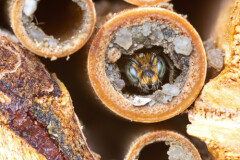What to Know About Mason Bees
What Are Mason Bees?
Mason bees make their nests between cracks in stones or other small, dark cavities. Once the female mason bee is finished laying her eggs, she will live up to her name and seal the cell with a thin wall of mud, clay, or other "masonry" product. Once the eggs yield full-grown bees, they mate and restart the cycle.
What’s the Difference Between Honey Bees & Mason Bees?
There are several key differences between honey bees and mason bees.
Honey Bees
- Build hives that support a colony
- Have one queen bee that lays all the eggs
- Produce and store honey
Mason Bees
- Use pre-existing tunnels for their nests
- Do not produce honey
- All females lay eggs
- Are solitary and work alone
Mason bees also emerge far earlier than honey bees and are significantly more effective at pollinating trees and flowering plants. And unlike European honey bees, mason bees are native to the United States.
Are Mason Bees Harmful?
No, mason bees are not harmful. Male mason bees lack a stinger and female bees are not aggressive or territorial, so they only sting if they are being harmed. Since they use existing holes for their nests, they don’t cause any damage – it's best to leave them "bee."
When Are Mason Bees Most Active?
Mason bees have an unusual life cycle, forming a cocoon at the end of summer and overwintering as adults. They emerge in early spring and are busy for roughly 4-6 weeks (April through June), disappearing until the following spring.
Call in the Bee Removal Experts
The best way to keep your outdoor entertainment zones free of bees is to bring in a professional, like Cleveland Bee Removal. We’ll first identify the bee, find its nesting areas, and safely remove them. If you think you have a mason bee problem, contact Cleveland Bee Removal today!


